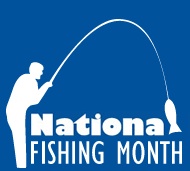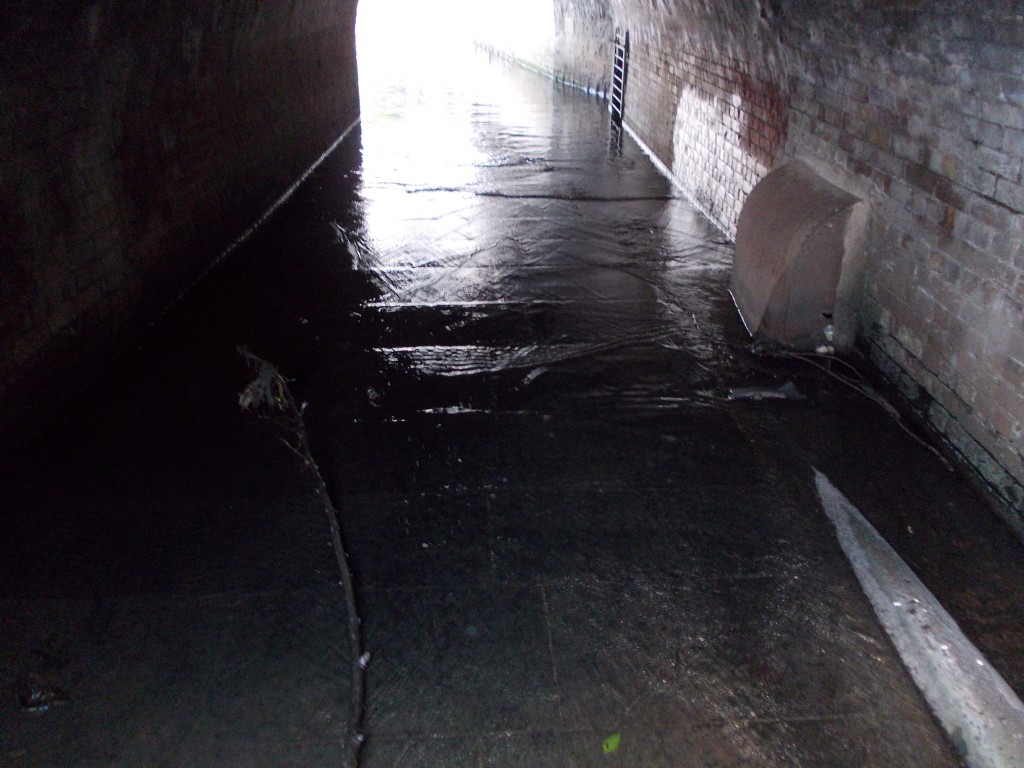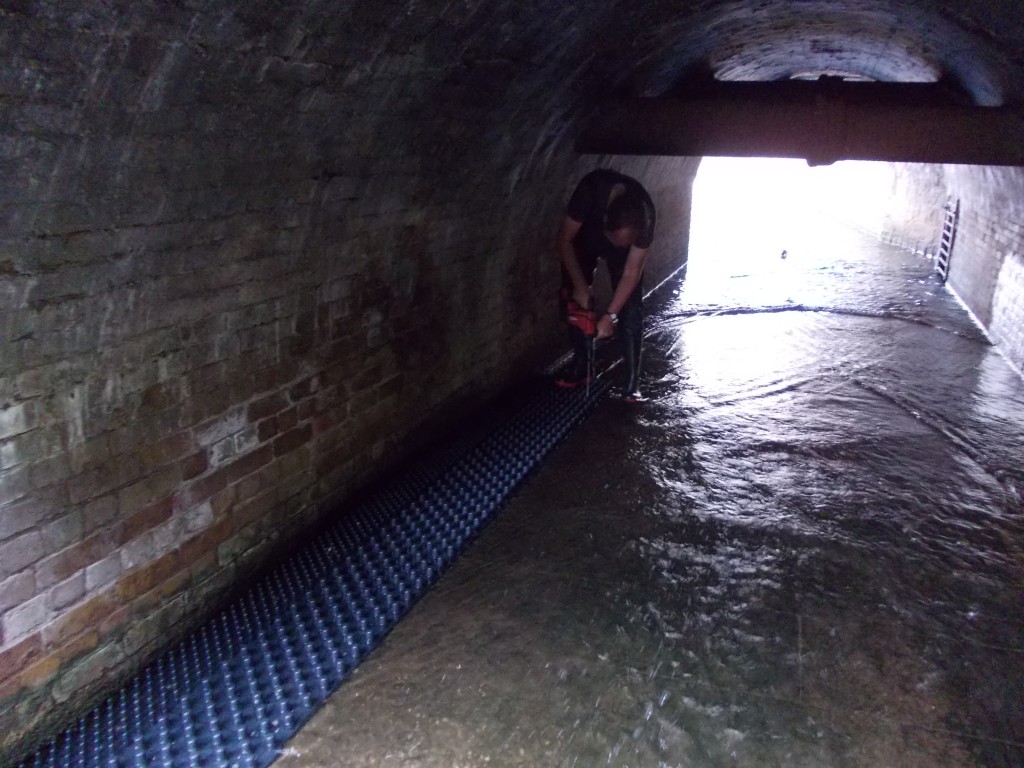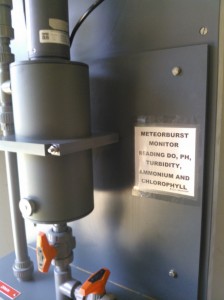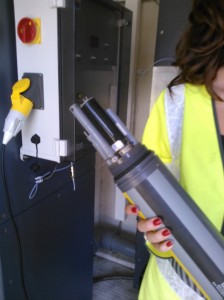-
- Buy a UK rod licence: EA Link
- 0800 807060 EA Hotline, Pollution, Poaching
- Thames Region River Levels
- Thames River Conditions
- Thames Temps and Clarity
- Thames Fishing Byelaws
- Thames Annual Tidefest
- Thames Record List
- Thames Eel Monitoring
- EA Annual Fisheries Report
- EA Flood Warnings
- Thames Sewage Discharge Notifications
- Thames Sewage Events
- Thames Tideway Tunnel
- River Thames Scheme: Reducing flood risk from Datchet to Teddington
- Martin Salter: Fighting for Fishing Blog
- Duncan Charmans World of Angling Blog
- Angling Trust
- Water and sewerage companies in England: environmental performance report 2013 – 2016
- EA Pollution incidents: 2014 evidence summary
- EA Pollution incidents: 2015 evidence summary
- River Crane and DNR Fisheries Impact assessment
- Links
Recent Tweets
Error retrieving tweetsNews Archive
National Fishing Month beats all Expectations
It began with a flying start back in mid-July when over 1,000 people were coached in coarse and game fishing by the Professional Anglers’ Association (PAA) and the Game Angling’ Instructors’ Association (GAIA) at the CLA Game Fair at Ragley Hall, Alcester. Enhanced by a visit from the Fisheries Minister, Richard Benyon and with new marketing initiatives enacted by supporting partners the Angling Trust and Get Hooked on Fishing (GHoF), NFM looked set fair for 2013.
The outstanding launch was backed by excellent attendances in the days that followed at other NFM events up and down Britain. The Albrighton Trust, based near Wolverhampton, organised a series of four events over the NFM period and successfully coached nearly 100 children at their wheelchair-friendly venue with large platforms that cater for anglers who have disabilities. Vicky Jevons, Administrator at the Albrighton Trust said: “All the kids had a great time and we had a number of new visitors attend. During the competition at our last NFM event, two young people who had never fished before won some of the Dunlop whips kindly donated by NFM supporter, Sports Direct.”
At Billingham Angling Club, Angling Trust Regional Officer Dave Munt worked in partnership with Stockton Youth Services on their event day. A local pond at Stillington was experiencing issues with anti-social behaviour on the site and so it was a great opportunity for Stockton Youth Services to coach a group of youngsters as well as show them how an angling club manages a site, demonstrating what is acceptable behaviour and what is not. It is now hoped that these young people will then attend coaching sessions at Stillington and take an active, positive role in the development of an angling club on the site.
Naidre Werner, Chairman of the Angling Trades Association (ATA), which runs NFM said: “National Fishing Month is the sport’s most important recruiting sergeant, and it is gratifying that we have exceeded our ambitious ceiling figure for 2013. This is largely due to the enthusiastic, steadfast support of the voluntary organisers and coaches who actually plan and facilitate the NFM events every year, as well as those tackle manufacturers and retailers who donate products for prizes and give-aways. Their generosity was both immense and crucial to this year’s unrivalled success." “This participation initiative is something that the Angling Trades Association is very proud to have created more than two decades ago, and I am confident that along with our long-standing supporting partners the Angling Trust, the PAA and the Environment Agency, and with newly-emerging relationships developing within other coaching groups, we can burst past the magic number of 20,000 participants in the near future.”
Posted in News
Tagged Angling Trust, Environment Agency, Fishing
Comments Off on National Fishing Month beats all Expectations
Angling Trust Announces fishing pioneer George Stephenson as its new Chairman
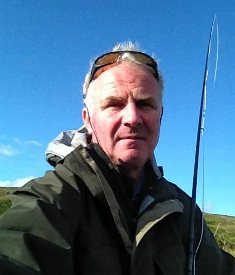 The Angling Trust has appointed fishing pioneer George Stephenson as its new Chairman, with immediate effect. With several decades experience of managing safari and fishing businesses around the world, George Stephenson brings great knowledge, business acumen and an excellent contact list to the role of Chairman of the rapidly-growing and dynamic representative organisation for all anglers in England.
The Angling Trust has appointed fishing pioneer George Stephenson as its new Chairman, with immediate effect. With several decades experience of managing safari and fishing businesses around the world, George Stephenson brings great knowledge, business acumen and an excellent contact list to the role of Chairman of the rapidly-growing and dynamic representative organisation for all anglers in England.
The post was widely advertised and attracted a number of high quality applicants. George Stephenson spent 25 years in Africa running safari camps before setting up a highly successful business for Roxton Bailey Robinson arranging fishing expeditions throughout the world. He is also Chairman of the Save the Rhino Campaign and he now lives on his farm in Wiltshire which includes two miles of the River Nadder and a carp lake. He has been a passionate all round angler since the age of 4, catching coarse, sea and game fish throughout the UK and around the world.
Among a host of notable catches in the UK and around the world, George considers the highlights to be a 23lb pike from the River Wye, a 32lb salmon from Iceland, a 96lb Nile Perch and a 30lb English Carp. Whilst he has caught many exotic species including long-tailed tuna on the fly from Kenya, sea trout from Argentina, black marlin, sailfish and tigerfish from Africa he still enjoys targeting brown trout, chub, grayling and bass back home in England. The new Chairman has identified a number of priorities for the organisation over the coming years, which include: Accelerating the steady growth in membership of the Trust among individuals, clubs, fisheries, riparian owners, the angling trade, and charter boats. Increasing fundraising from private donors and corporate sponsorship to support specific campaigns and the English national angling teams. Continuing to develop the relationships with Sport England and in particular the Environment Agency to deliver the National Angling Strategy. Working more closely with the various disparate angling organisations in Wales and Scotland to create more unified representation for anglers throughout the UK. Recruiting new volunteers to the Angling Trust board to provide strategic direction to an organisation that turns over nearly £2.5 million a year and employs nearly 40 staff.
Mike Heylin has served as Chairman since shortly after the formation of the Trust in 2009, and announced his intention to step down at the AGM in 2012. He will remain as a member of the Board of Directors for the time being and said: “I feel privileged to have served the angling community for the past four years and proud of what the organisation has achieved in that time. I warmly welcome George Stephenson’s appointment to the role and feel that he has the skills and experience the organisation needs to take it forward to the next step in its development.”
New Angling Trust Chairman, George Stephenson said: “I am delighted and honoured to have this opportunity to give something back to fishing, which has been a very important part of my whole life. Mike Heylin, Mark Lloyd and all the Directors and staff of the Angling Trust should be congratulated for the enormous progress they have made since 2009 in unifying the angling community to support a single representative organisation. I look forward to working closely with them to develop plans to build on the success of the past four years. It is essential that all anglers are made aware of the excellent work being done on their behalf by the Angling Trust and its partner organisation Fish Legal.”
Fisheries Minister Richard Benyon said: “I have been very impressed by the Angling Trust and all that it has achieved in the past four years. They have robustly made the case for the protection of fish stocks and anglers’ right to fish for them and they are developing a wide range of programmes to deliver the National Angling Strategy which I launched last year. I know of George’s work and very much welcome his appointment as Chairman – his knowledge and experience of the world of angling and fisheries will, I’m sure, be very useful to the Trust in the next stage of its development. No doubt I will be hearing from him and his executive team often in my role as Fisheries Minister!”
Mark Lloyd, Chief Executive of the Angling Trust & Fish Legal said: “On behalf of all the staff and volunteers, I would like to thank Mike Heylin for the immense amount of time, energy and enthusiasm he has given to the Angling Trust. His dedication to angling and fisheries over forty years has culminated with a huge contribution to the formation and early development of our unified representative body. I am very grateful to George Stephenson for volunteering to take on this role and I am looking forward very much to working alongside him and the rest of the board to build on our success so far.” Charles Jardine, from Fishing for Schools, said: “I am utterly delighted to hear of George’s appointment and I enthusiastically endorse him as the new Chairman of the Angling Trust as the unified body for all anglers. He is a beacon of common sense, someone who knows what the future needs – and how to get there.”
Posted in News
Tagged Angling Trust, Fishing
Comments Off on Angling Trust Announces fishing pioneer George Stephenson as its new Chairman
Eels get a helping hand in the Hogsmill River
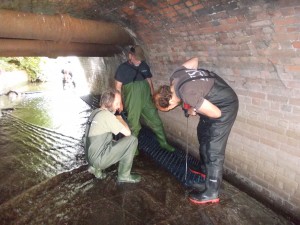 Volunteers and staff from the Thames Anglers Conservancy and the Zoological Society of London (ZSL) joined forces in a project spearheaded by the Wandle Trust (Part of the new South East Rivers Trust), to help eels enter the Hogsmill River that runs through the centre of Kingston.
Volunteers and staff from the Thames Anglers Conservancy and the Zoological Society of London (ZSL) joined forces in a project spearheaded by the Wandle Trust (Part of the new South East Rivers Trust), to help eels enter the Hogsmill River that runs through the centre of Kingston.
The European eel is now considered Critically Endangered due to the drop in the number of young eels (elvers) entering our rivers. It is a wonderful and iconic species with a life cycle that encompasses a 10,000 km round trip from the Sargasso Sea. Despite being such a long distance traveller eels aren’t particularly good swimmers .
Volunteers from Kingston University, with the support of ZSL, have been monitoring the number of elvers (young eel) migrating up the Hogsmill and are yet to find any. A possible reason for this is that they can’t get past the steep smooth concrete channel under the Historic Clattern Bridge.
The smooth slope which was a barrier to eel migration
Tim Longstaff of the Wandle Trust said “By adding special tiles to the riverbed that give the eels something to crawl through we hope that we can help them enter the Hogsmill. If we can open up all of London’s rivers more eels will grow to maturity in London meaning more will be able to swim back to the Sargasso Sea to breed”
Dave Harvey of the TAC said ‘’ It’s great to be able to contribute to helping conserve the eel by doing this work on the Hogsmill. We have been monitoring Eel migration at Molesey for 2 years and to know that their passage into this important Thames tributary has now been improved is fantastic news.
The run of tiles nearing completion
Environment Agency Rescued Thousands of fish Distressed by the Heatwave
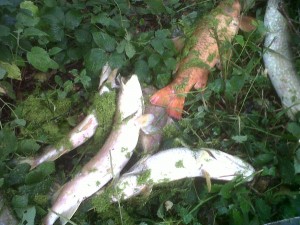 Environment Agency teams across the country have been rescuing thousands of fish in distress as a result of the recent weather.
Environment Agency teams across the country have been rescuing thousands of fish in distress as a result of the recent weather.
Hot weather combined with low rainfall can make fatal conditions for fish, while heavy intense rain also leads to an increase in diffuse pollution as result of pollutants washed off roads, sewerage systems and from agricultural land. Rapid changes in water conditions mean that there is little time for fish to acclimatise. Oxygen levels in the water can become dangerously low meaning that fish are at risk of suffocating or becoming more prone to stress and disease. Nearly 50,000 fish deaths Due to the weather, July saw more than 15 separate incidents leading to nearly 50,000 fish deaths, however many more thousands were saved thanks to the swift action taken by Environment Agency teams and partners.
In Welney, Norfolk, the Environment Agency’s fast response to poor water quality prevented huge numbers of fish deaths. Routine monitoring results showed a significant dip in dissolved oxygen levels in the river. Water aerating equipment was installed and teams treated the water daily to increase dissolved oxygen levels.
At Pitville Park Lake in Cheltenham expert teams worked round the clock and used specialist pumping equipment to restore oxygen levels. Oxygen level drop In Tiptree village pond, Essex, there were reports of hundreds of fish in distress and approximately 50 dead. When Environment Agency teams arrived on the scene, oxygen levels were down to three per cent. Aeration pumps were used to boost oxygen levels back to a healthy state – at least 40 per cent.
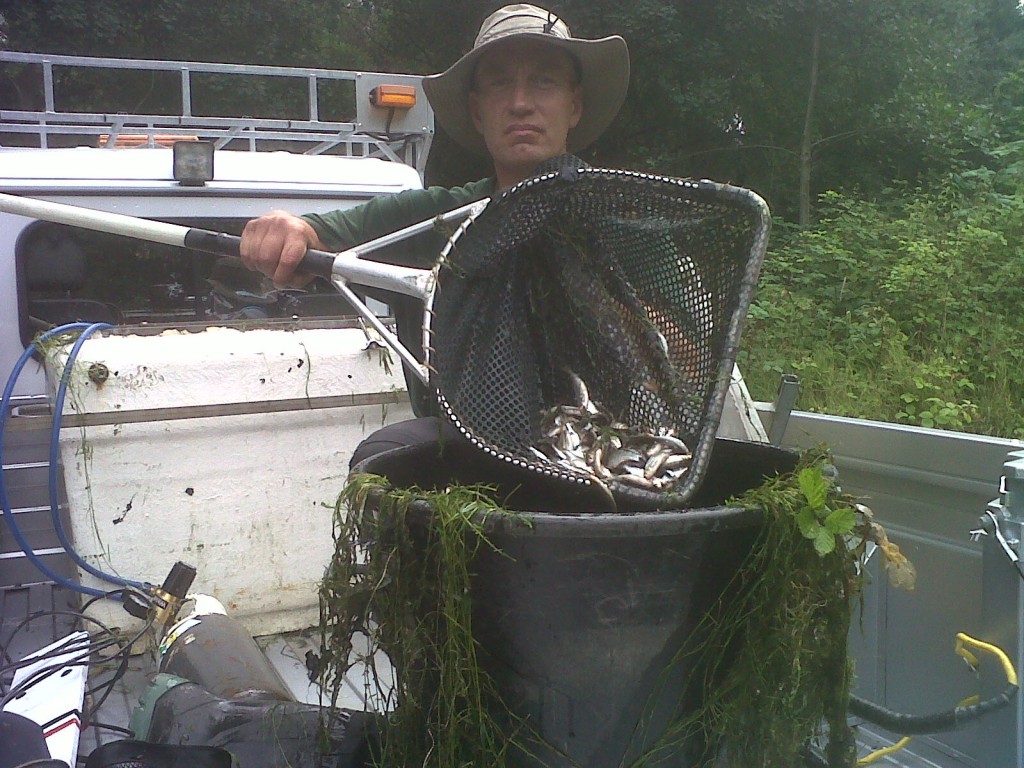 West Thames Fisheries Officer Stuart Keable rescuing fish from the Basingstoke Canal
West Thames Fisheries Officer Stuart Keable rescuing fish from the Basingstoke Canal
Anglers and other people enjoying the riverside are being urged to promptly report any signs of distressed, diseased or dead fish to the Environment Agency’s incident hotline.
Geoff Bateman, Head of Fisheries and Biodiversity at the Environment Agency, said: 'Long periods of hot weather with low rainfall can be deadly for fish. The Environment Agency has a 24 hour Incident Hotline on 0800 80 70 60 and we encourage anglers and people out enjoying rivers, canals and lakes to call if they see fish gasping for air. With the help of the public we can continue to react quickly and help protect wildlife. 'People at home can also play their part by using water wisely; the less people take from the tap means more for our rivers and the wildlife which they support.'
The Environment Agency is advising owners of ponds and fisheries to keep a close eye on the situation during warm weather and be prepared to respond if fish are in distress. The tell-tale signs of fish in distress are fish gasping at the water’s surface or swimming on their sides or upside down.
Yet more Hydropower omnishambles as Environment Agency ducks decision to protect our rivers
 Angling and conservation groups have expressed alarm at the continued delay in properly regulating the use of hydropower turbines on English rivers despite admissions that the current guidelines for hydropower schemes were 'not fit for purpose' and risked long-term environmental damage to fish and other ecology.
Angling and conservation groups have expressed alarm at the continued delay in properly regulating the use of hydropower turbines on English rivers despite admissions that the current guidelines for hydropower schemes were 'not fit for purpose' and risked long-term environmental damage to fish and other ecology.
At a meeting of on Thursday 11 July, the Environment Agency (EA) board failed to approve new Good Practice Guidelines for hydropower developments because of a lack of evidence provided by the EA executive team to support their recommendations that higher flow protection standards should be adopted. The Angling Trust, Fish Legal, Salmon & Trout Association, Atlantic Salmon Trust, Buglife and WWF have today demanded a moratorium on all new developments until the necessary evidence has been gathered to enable a decision to be taken to protect rivers from further damage. This latest delay follows years of broken promises and delays with the process of developing the new guidelines.
The meeting was expected to approve the executives' recommendation to adopt new guidelines which would have reduced the amount of water that could be diverted from rivers into hydropower turbines. The proposed guidelines were supported by angling and fisheries NGOs who have attended more than 20 meetings to help draw them up.
Their position was based on the best available evidence world-wide, including scores of scientific papers and a review of flow requirements commissioned by the Agency itself from a renowned expert in the field. Angling and fisheries NGOs have repeatedly pressed the Environment Agency, from the Chief Executive down, to monitor the 100 or so developments that have been approved to see what impact they have had on fish and other ecology in rivers. However, all these warnings have been ignored and this has led to the situation where the EA Board felt it did not have the information necessary to take a decision to protect the environment.
The executives failed to refer to the considerable body of scientific literature drawn to the Agency's attention by the NGOs throughout the drawn-out review process. The NGOs have now written to EA Chairman Lord Chris Smith who expressed concern at the lack of information made available to the Board and stated that the bottom line must be "what is the best option for the environment". The NGOs have formally called for a moratorium on approving any further hydropower applications until the new guidelines are in place.
Mark Lloyd, Chief Executive of the Angling Trust and Fish Legal, who attended the meeting and gave a presentation on behalf of angling and fisheries organisations, said: "we have repeatedly highlighted the Environment Agency's shambolic handling of the regulation of hydropower in recent years and this latest development confirms that it continues to be a complete farce. No developments should be allowed on our precious rivers, which already suffer from low flows and diffuse pollution, unless they can be proven to be environmentally benign. The Environment Agency cannot go on allowing developers to profit from installing turbines on our rivers without monitoring their impact, especially as these schemes, once established, will be there for generations. The Environment Agency simply must take a precautionary approach and call a halt to developments until they can obtain the necessary information to support their expert judgement that the current guidelines are not fit for purpose and are in need of a radical overhaul."
Paul Knight, CEO of the Salmon & Trout Association, added; "Surely it is logical that if the EA Board does not have sufficient evidence available to ratify the new Good Practice Guidelines, then its staff cannot have the data on which to licence individual hydropower applications, yet these are still being granted at an alarming rate. We appreciate the pressure on the EA to encourage renewable energy schemes. However, low head hydropower will only ever contribute very limited localised benefit, but has the potential to significantly damage river ecosystems by depleting water flows, causing barriers to fish movements and the natural dynamics of rivers, and destroying habitats for fish and aquatic insects, with a knock-on effect to birds and mammals. We look to the EA Board to send out a strong message that the aquatic environment and its dependent species must be protected, not sacrificed for the political perception that hydropower is a 'green' energy source."
To read the joint letter to Lord Smith from The Angling Trust, Fish Legal, Salmon & Trout Association, Atlantic Salmon Trust, Buglife and WWF CLICK HERE.
Posted in News
Tagged Angling Trust, Environment Agency, Fish KIll, Hydropower, Pollution, WFD
Comments Off on Yet more Hydropower omnishambles as Environment Agency ducks decision to protect our rivers
EA Water Report shows River flows declined in June
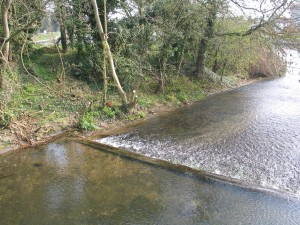 The Environment Agency Water Situtaion report for June 2013 shows rainfall was considerably lower than average, but the wet winter and cooler than average spring and early summer mean that this has not had a great impact on groundwater levels or river flows.
The Environment Agency Water Situtaion report for June 2013 shows rainfall was considerably lower than average, but the wet winter and cooler than average spring and early summer mean that this has not had a great impact on groundwater levels or river flows.
Rainfall
Rainfall was just under 40% of the long term average fo r the South East this month, the driest June for 7 years. North West Grain and Sheppey on the North Kent coast had the 3 rd driest June since records began in 1910. There were some sporadic showers during the month, but no daily rainfall totals above 20 mm were recorded. Spring and early summer have been drier than usual and April to June rainfall totals are only 71% of average for the Region
Soil Moisture Deficit
Recharge and Groundwater Levels Soil moisture deficits ended the month around 20mm great er than the mean for June as a result of the low rainfall. Recharge totals were low, as is usual at this time of year when evaporation is high. Groundwater levels are still noticeably impacted by t he wet conditions over the winter, with five sites across the Region above normal and levels at Lilley Bottom in the Mimram catchment notably high . Stonor Park, Well House Inn and Clanville Lodge all had the highest levels for the end of June since 2001. Carisbrooke Castle on the Isle of Wight recorded exceptionally high levels this month, however the behaviour of this site is known to be erratic at times. Clanville Lodge had the 4 th highest level for June on record, only 1.8m lower than that recorded in 2001, the highest. Groundwater levels declined during the month at all the key sites, as is usual at this time of year.
River Flows
River flows declined during the month, with little contribut ion from rainfall. Despite the low rainfall, most of the key sites had normal flows for the time of year, and a few mainly groundwater dominated sites had above normal flows. This disparity is the result of t he wet winter and the cooler than average spring and early summer. The Test at Broadlands has had the highest April to June flows since 2001, as a result of the high groundwater levels in the catchment. There we re no flood alerts or warnings issued this month.
Reservoir Storage/Water Resource Zone
Stocks Reservoir storage fell this month for all the reservoirs other than those supplied from the River Thames. Storage remains above average for the time of year, except for the small rese rvoir at Darwell, where storage is slightly lower than average.
Full Report HERE
Posted in News
Tagged Drought, Environment Agency, Fish, Thames, Water Report
Comments Off on EA Water Report shows River flows declined in June
Pollution Wipes out Riverflies on 15km of the Upper Kennet
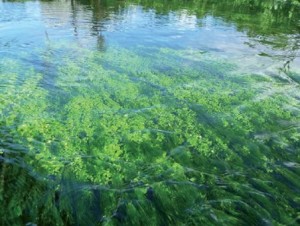 A serious pesticide pollution has hit the upper River Kennet this week resulting in an almost total wipe out of the aquatic invertebrates in much of a 15 km stretch downstream from Marlborough to Hungerford. As yet fish populations remain unscathed but there are concerns that there may be residual effects that are still to come.
A serious pesticide pollution has hit the upper River Kennet this week resulting in an almost total wipe out of the aquatic invertebrates in much of a 15 km stretch downstream from Marlborough to Hungerford. As yet fish populations remain unscathed but there are concerns that there may be residual effects that are still to come.
(Picture:Angling Trust)
Much of this stretch of famous chalk river, renowned for its trout fishing, is situated within a SSSI. The Environment Agency has identified the pollutant as chlorpyrifos, an organophosphate that is highly toxic to insect life. The source is as yet unknown but it entered the river by passing through the Marlborough Sewage Treatment Works. No damage appears to have been done to the works themselves.
A team of specialists from both Thames Water and the EA are working together on trying to track down the cause and origins of the pollution. Chlorpyrifos is used on lawns and golf courses and to tackle insects on crops and some soft fruits. It is the same pollutant that wiped out a large section of the River Wey in 2003 and led to a significant fish kill on the Sussex Ouse in 2001.
It was banned in Singapore in 2009 for use in termite control in soil and the United States phased out chlorpyrifos for use in buildings and residential homes and pre-construction sites from 2001 due to public health and environmental concerns. The US Environmental Protection Agency (EPA) has moved to limit the use of the chemical near salmon rivers because of possible damage to fish and has been petitioned to introduce a total ban following reports that it can cause damage to human health.
The pollution was discovered on Monday by volunteer riverfly monitors working for Action for the River Kennet (ARK). In their statement ARK said: "The Environment Agency were immediately alerted, as well as the downstream river keepers. By this morning the pollution had spread from the Elcot Lane area to beyond Ramsbury, but the river upstream of Elcot was healthy. The Environment Agency are currently investigating the extent and cause of the incident. Although few fish appear to have been killed the absence of invertebrates means that both fish and other wildlife have nothing to eat, which will have a serious impact on the river's ecology.
ARK have a team of over 50 volunteer riverfly monitors who monitor over 20 sites on the Kennet every month." The Angling Trust have been involved throughout and have been liaising with both Thames Water and the EA. Their Campaigns Coordinator Martin Salter will be attending the forthcoming meeting organised by the EA to discuss the incident with river keepers and fishery interests.
Mark Owen, Freshwater and Environment Campaigns Manager for the Angling Trust said: "This is a truly appalling pollution which seems to have been caused by a small amount of lethal pesticide which entered the sewerage system in the Marlborough area. We very much support the work to track down both the source and those responsible for the pollution and our colleagues at Fish Legal are ready to take action on behalf of our member clubs. Even if fish stocks remain untouched there is now precious little left for the fish or other wildlife to eat which is why the Angling Trust is calling for measures to try and recolonise the affected stretches with invertebrates as quickly as possible. We will support any measures the EA recommend to restore invertebrate communities in a sustainable manner."
Martin Salter added: "The Angling Trust wants to know why on earth a lethal chemical like chlorpyriphos is allowed to be used anywhere near a river or watercourse. Apparently the 15 kms wipeout of invertebrates between Marlborough and Hungerford may have been caused by as little as a couple of spoonfuls of the stuff. If this is the case then the sooner we follow the lead of Singapore and America and ban it the better. We shall be asking the Environment Agency to immediately add this chemical to their Watch List of Priority Hazardous Substances to ensure all water bodies are monitored for the presence or absence of this chemical in our rivers."
Notes: Singapore Ban http://app2.nea.gov.sg/docs/default-source/anti-pollution-radiation-protection/chemical-pollution/prohibition-on-the-use-of-chlorpyrifos-in-singapore.pdf?sfvrsn=0
USA Environmental Groups Seek Ban of Common Pesticide Chlorpyrifos http://www.boisestatepublicradio.org/post/environmental-groups-seek-ban-common-pesticide-chlorpyrifos
Posted in News
Tagged Angling Trust, Chalkstream, Drought, Environment Agency, Fish, Pollution, Thames Water
Comments Off on Pollution Wipes out Riverflies on 15km of the Upper Kennet
Severn Trent Water fined 20K for breaching permit
 On 2 July 2013, Severn Trent Water Ltd pleaded guilty at Nottingham Magistrates’ Court to one charge of breaching the condition of their Environmental Permit, resulting in the pollution of Cotgrave Brook, Nottingham. The charge was brought by the Environment Agency contrary to Regulation 38(2) of the Environmental Permitting Regulations 2010.
On 2 July 2013, Severn Trent Water Ltd pleaded guilty at Nottingham Magistrates’ Court to one charge of breaching the condition of their Environmental Permit, resulting in the pollution of Cotgrave Brook, Nottingham. The charge was brought by the Environment Agency contrary to Regulation 38(2) of the Environmental Permitting Regulations 2010.
The company was fined £20,000 and ordered to pay £3,015.25 in costs. Environment Agency Prosecutor, Sheila Abrahams, told the court that on 15 December 2011, a malfunction of the sand-filters at the Severn Trent Water (STW) Cotgrave sewage treatment works, caused discharge of untreated sewage to pollute 1km of the Cotgrave Brook. The operation of the Severn Trent Water Cotgrave sewage treatment works is authorised by an environmental permit, giving them a responsibility to ensure their sewage treatment works are operated and maintained in a way that minimises their impact on the environment.
The STW had previously been given three formal written warnings for similar breaches in October 2011.
Speaking after the case, Vicky Laycock, Environment Agency officer in charge of the investigation, said: “Although Severn Trent Water reported the discharge to us immediately, it was too late to prevent the pollution of the Cotgrave Brook. We do everything we can to protect the environment, local rivers and watercourses. This case sends out a clear message that we will not hesitate to prosecute as necessary when environmental damage is caused.”
In mitigation, Severn Trent Water apologised for the breach of their permit and admitted that they could have done more. As a result of the earlier incidents in October 2011 Severn Trent Water Limited had sought and acted upon advice from Sand Filter Specialists, they had adjusted the low flow alarms at the sewage treatment works so they alarmed earlier and they commissioned other contractors to flush and clean the sand filters. Since the incident in December 2011 they have now fitted alarms to the storm tanks, sample the sand filters weekly and visit the works on a daily basis. The cost of these works amounts to £17,000. Rivers and watercourses are an important part of the environment, and there is an increasing awareness of the necessity to preserve them from pollution.
If you see pollution or a waste crime incident, report it on our incident hotline on 0800 80 70 60 or anonymously to Crimestoppers on 0800 555 111.
Posted in News
Tagged Environment Agency, Fish KIll, Pollution, Sewage
Comments Off on Severn Trent Water fined 20K for breaching permit
Thames Water to pay £41,000 for Pollution and Fish Kill on the River Ash
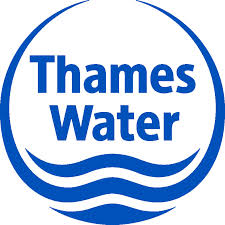 Thames Water Utilities Limited (Thames Water) has been ordered to pay £41,000 for polluting the River Ash and for breaching a condition of its environmental permit, killing an estimated 4,300 fish.
Thames Water Utilities Limited (Thames Water) has been ordered to pay £41,000 for polluting the River Ash and for breaching a condition of its environmental permit, killing an estimated 4,300 fish.
In May the company pleaded guilty to two charges in relation to the pollution of the river between August 8 and 14, 2010. It was fined £17,500 at Staines Magistrates’ Court on Friday (June 14) and was also ordered to pay costs of £23,500 and a victim surcharge of £15. Thames Water was convicted after discharging polluting matter from its Ashford Common Water Treatment Works (ACWTW), which was not in accordance with its permit issued by the Environment Agency.
The company was also convicted on one other charge of breaching a permit condition as dissolved oxygen levels were less than the required 50% during the same period in August 2010. Magistrates said the incident was ‘foreseeable’ and that Thames Water’s contingency plan was ‘inadequate’ for its planned engineering works when the pollution occurred. However the company did confirm they had spent £190,000 on improving its treatment works and a further £90,000 on a study regarding the long term suitability of the plant.
Environment Officer Luke Tobitt said: “As the regulatory authority for Inland Freshwaters, the Environment Agency has a wide range of responsibilities under legislation to protect and improve the water environment. Clean water is an essential resource for commercial activities, recreation, fisheries and local wildlife. “Although Thames Water has had previous convictions, this is the first time it has been successfully prosecuted in relation to a water treatment works and blue green algae. It was a complex and resource-intensive case and we are satisfied to have recovered a significant proportion of the costs incurred whilst conducting the investigation. “The prosecution and fining of Thames Water sends a clear message to companies that if they fail in their environmental responsibilities they may be prosecuted.”
The River Ash flows from Staines through Ashford and joins the River Thames at Sunbury. The river is a fish spawning ground for the River Thames and provides an excellent habitat to support fish populations. Treated water from the ACWTW goes firstly into a lagoon on site and then discharges via a discharge pipe at Nutty Lane. On August 8, 2010, members of the public reported dead and dying fish on the River Ash to the Environment Agency. An Environment Officer witnessed the discharge in the form of a blue/grey effluent in to the River Ash.
The total length of the river affected by this pollution was 2.7km. Dead fish were observed on the river by one Environment Officer. A total of 207 fish were recovered from a 120 metre stretch. A minimum estimate by the Agency of total fish mortalities across the affected areas of the river was 4,300 of varying species. The discoloured water was witnessed by local residents and some undertook a fish rescue. One environment officer conducted a dye trace that demonstrated the link between the lagoon in ACWTW and the outfall at Nutty Lane.
When Thames Water was interviewed it stated it had no choice but to discharge from the lagoon on site through the discharge outfall to the river otherwise properties surrounding the lagoon would have been flooded. Thames Water later discharged effluent straight from the works, by-passing the lagoon.
Posted in News
Tagged Environment Agency, Fish, Fish KIll, Pollution, Sewage, Thames Water
Comments Off on Thames Water to pay £41,000 for Pollution and Fish Kill on the River Ash


